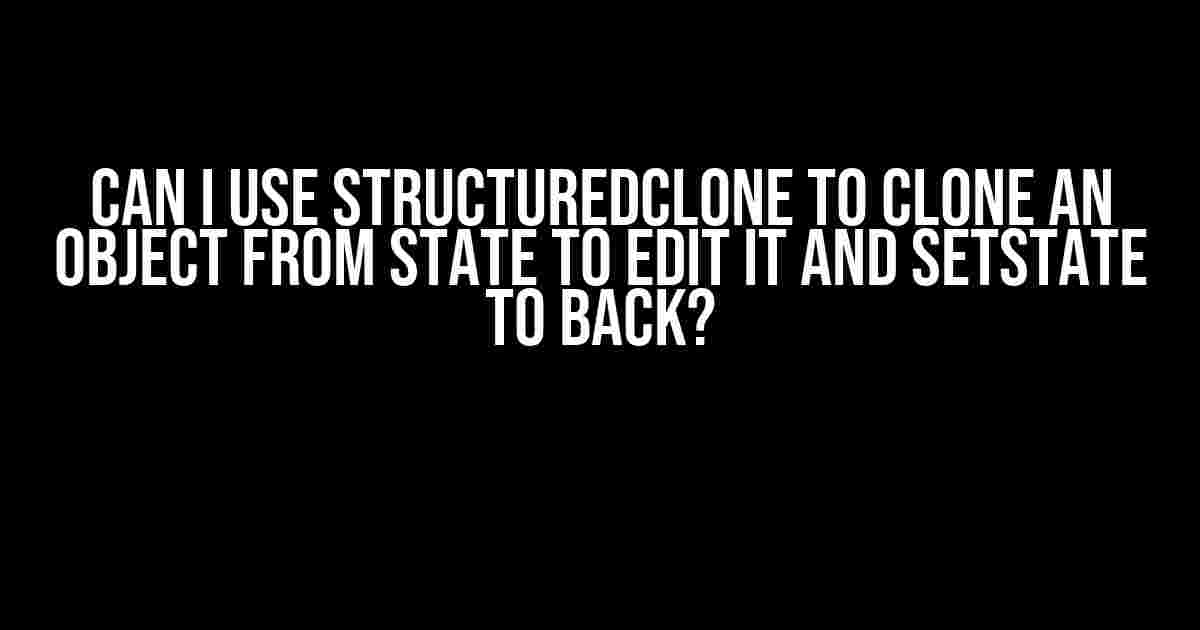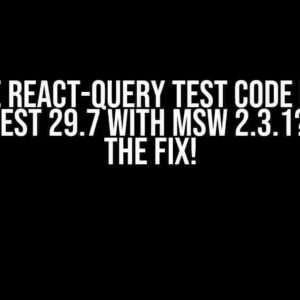Have you ever found yourself in a situation where you need to clone an object from your state, make some changes to it, and then update the state with the new data? Well, you’re in luck because this article is here to guide you through the process using the powerful `structuredClone` function.
What is structuredClone?
`structuredClone` is a new function introduced in ECMAScript 2022 that allows you to create a deep copy of a JavaScript object. Unlike other cloning methods like `JSON.parse(JSON.stringify(obj))`, `structuredClone` is able to preserve the references of the original object, making it a more efficient and reliable way to clone complex data structures.
const originalObject = {
name: 'John',
address: {
street: '123 Main St',
city: 'Anytown',
state: 'CA'
}
};
const clonedObject = structuredClone(originalObject);
console.log(clonedObject === originalObject); // false
console.log(clonedObject.address === originalObject.address); // falseThe Problem: Editing State without Mutating the Original
When working with React or other state-driven applications, it’s common to encounter a situation where you need to edit an object from your state, but doing so directly would mutate the original state. This is where `structuredClone` comes in handy.
Let’s say you have a state object like this:
const [ gameState, setGameState ] = useState({
player: {
name: 'John',
score: 0
},
levels: [
{
id: 1,
title: 'Level 1'
},
{
id: 2,
title: 'Level 2'
}
]
});And you want to edit the `player` object without mutating the original state. You could try something like this:
const editPlayer = () => {
const newPlayer = gameState.player;
newPlayer.score += 10;
setGameState({ ...gameState, player: newPlayer });
};But, oh no! You’ve just mutated the original state. The `newPlayer` object is still referencing the same object as `gameState.player`, so when you update `newPlayer`, you’re also updating the original state.
The Solution: Cloning State with structuredClone
To avoid mutating the original state, you can use `structuredClone` to create a deep copy of the `gameState` object. Here’s an updated version of the `editPlayer` function:
const editPlayer = () => {
const clonedGameState = structuredClone(gameState);
clonedGameState.player.score += 10;
setGameState(clonedGameState);
};By cloning the `gameState` object, you can safely edit the `player` object without worrying about mutating the original state. When you’re done, you can update the state with the new cloned object.
Why is this better than other cloning methods?
There are several reasons why `structuredClone` is a better choice than other cloning methods:
- Preserves references**: Unlike `JSON.parse(JSON.stringify(obj))`, `structuredClone` preserves the references of the original object, ensuring that nested objects and arrays are properly cloned.
- Handles circular references**: `structuredClone` can handle circular references, which can be a problem with other cloning methods.
- Faster and more efficient**: `structuredClone` is generally faster and more efficient than other cloning methods, especially for large and complex data structures.
Best Practices for Using structuredClone
Here are some best practices to keep in mind when using `structuredClone`:
- Clone only when necessary**: Only clone objects when you need to edit them. Cloning large objects can be expensive, so avoid unnecessary cloning.
- Use with caution with complex data structures**: While `structuredClone` can handle complex data structures, it’s still important to be mindful of performance implications when cloning large objects.
- Avoid cloning functions and APIs**: `structuredClone` cannot clone functions and APIs, so avoid trying to clone objects that contain these types of properties.
- Test thoroughly**: Always test your code thoroughly when using `structuredClone` to ensure that it’s working as expected.
Conclusion
In conclusion, `structuredClone` is a powerful function that can help you clone objects from your state, edit them safely, and then update the state with the new data. By following best practices and using `structuredClone` judiciously, you can ensure that your code is efficient, reliable, and easy to maintain.
| Method | Description | Preserves References | Handles Circular References | Performance |
|---|---|---|---|---|
| JSON.parse(JSON.stringify(obj)) | Converts object to JSON and back to object | No | No | Slow for large objects |
| Object.assign({}, obj) | Copies properties to new object | No | No | Faster than JSON method, but still slow |
| structuredClone(obj) | Creates a deep copy of the object | Yes | Yes | Fast and efficient, even for large objects |
I hope this article has helped you understand how to use `structuredClone` to clone objects from your state, edit them safely, and then update the state with the new data. Happy coding!
Frequently Asked Question
Get the scoop on using structuredClone to clone an object from state and set it back with setState!
Can I use structuredClone to clone an object from state to edit it and setState to update it?
Yes, you can! structuredClone creates a deep copy of the object, allowing you to edit it without mutating the original state. Then, you can use setState to update the state with the edited clone.
What’s the benefit of using structuredClone over regular assignment or the spread operator?
structuredClone creates a deep copy of the object, whereas regular assignment or the spread operator only create a shallow copy. This means that changes to the clone won’t affect the original state, ensuring data integrity and preventing unintended side effects.
Can I use structuredClone to clone an object with nested properties?
Absolutely! structuredClone recursively clones objects, including nested properties, so you can safely edit the clone without worrying about affecting the original state.
Is using structuredClone and setState a good practice for handling complex state updates?
Yes, this approach is a good practice for handling complex state updates. It allows you to temporarily edit a clone of the state, making it easier to manage complex updates and ensuring that your state remains consistent and predictable.
Are there any performance implications when using structuredClone and setState?
While structuredClone can be slower than shallow copying methods, the performance impact is usually negligible. Additionally, the benefits of using structuredClone and setState, such as data integrity and predictability, often outweigh any minor performance costs.


